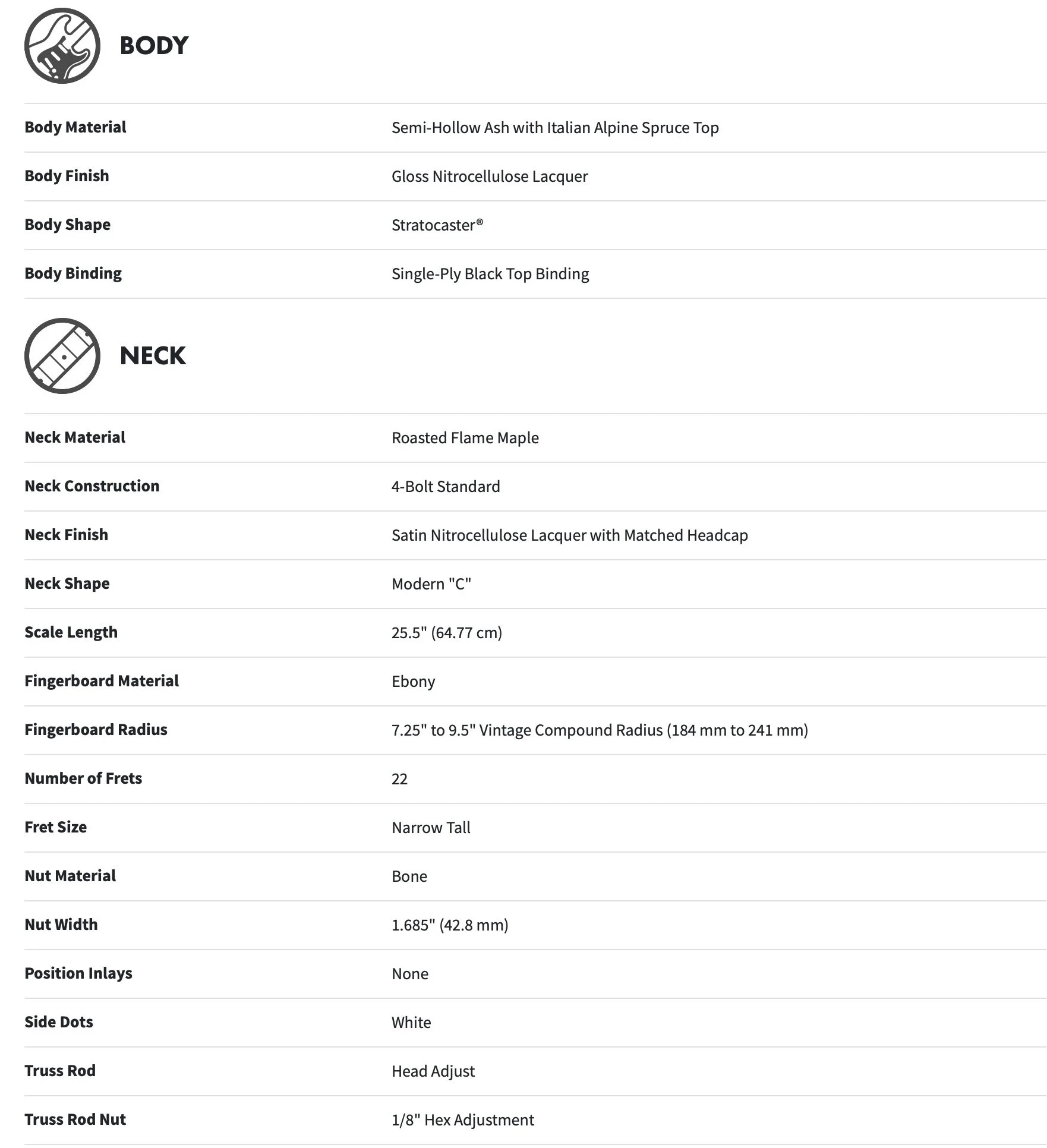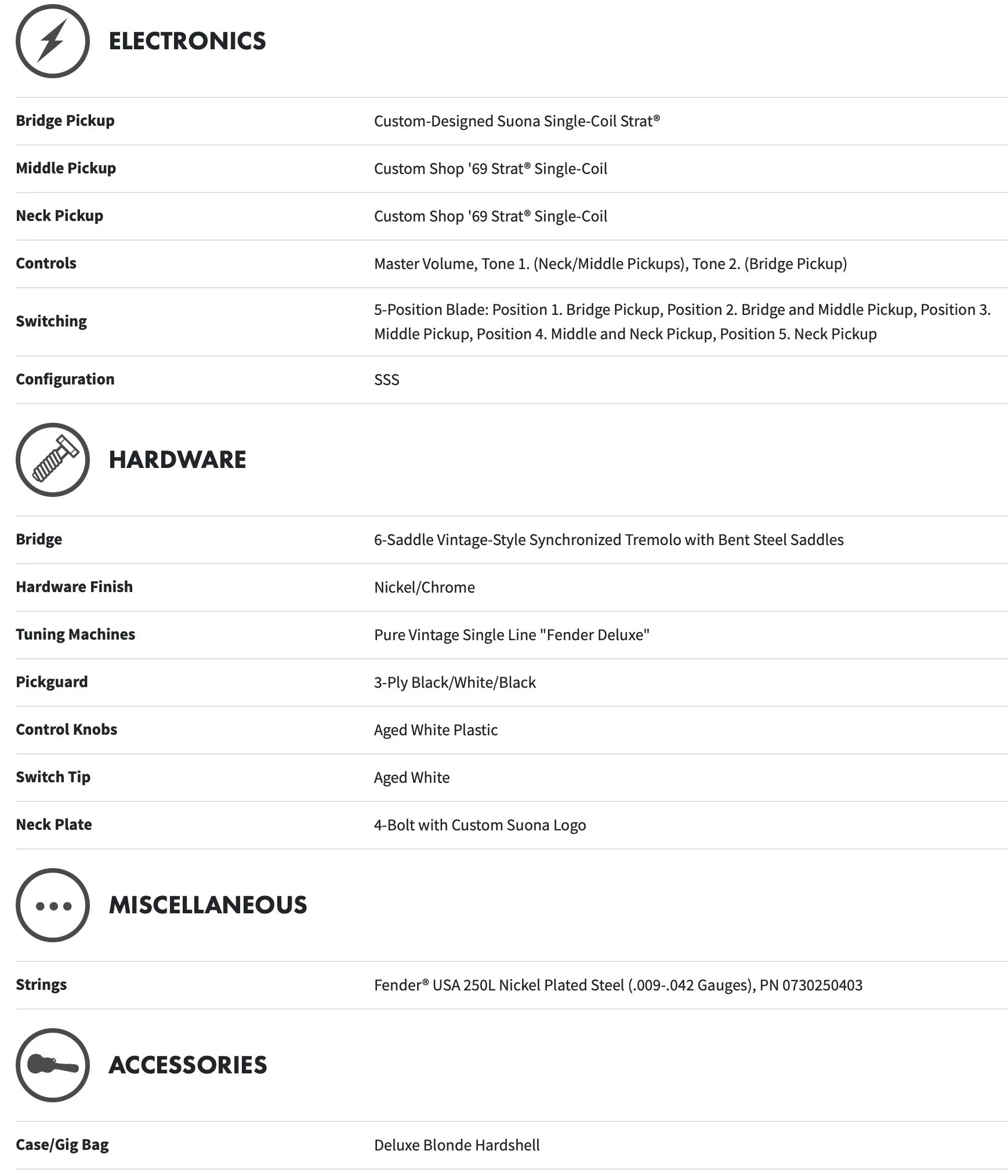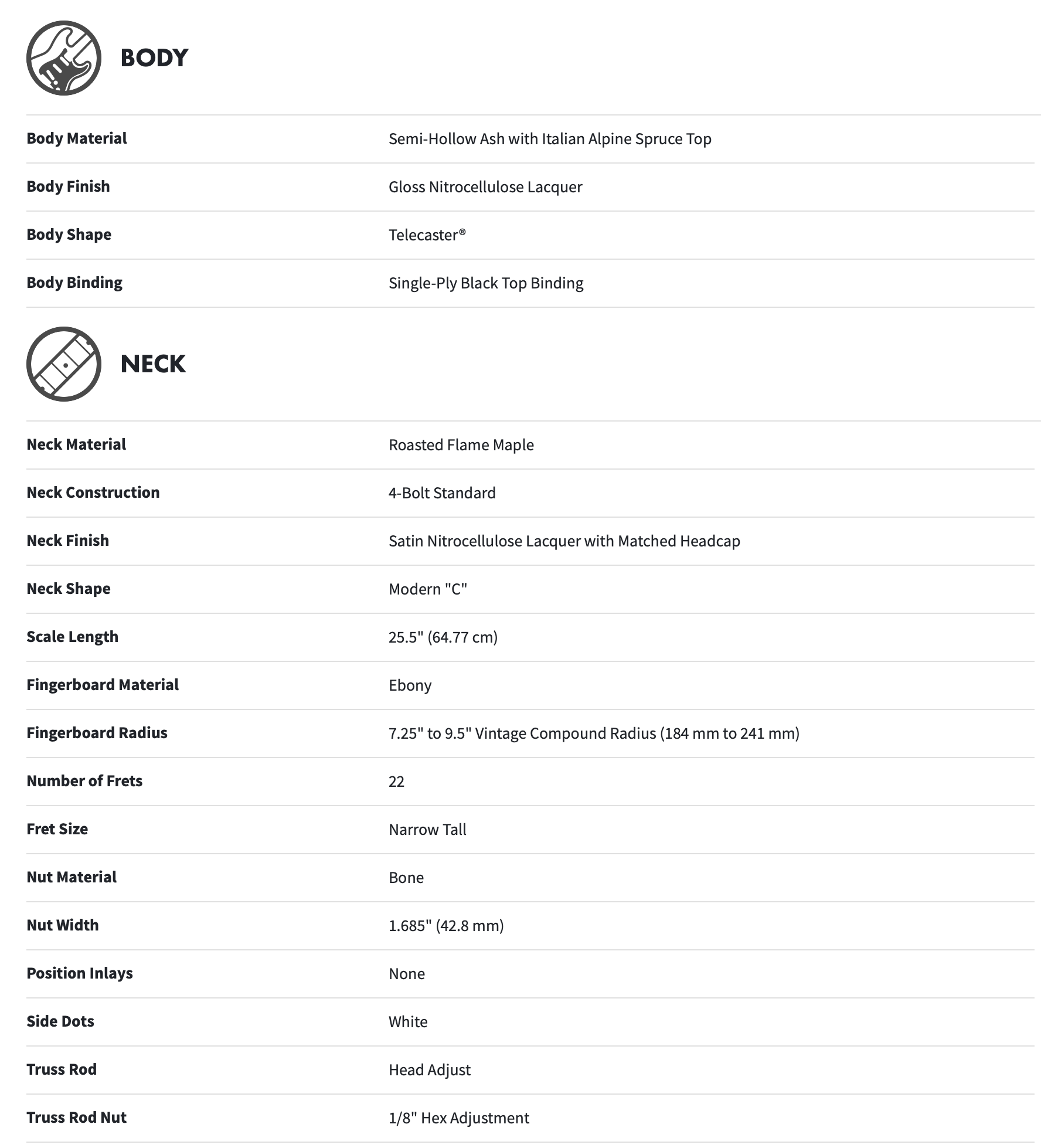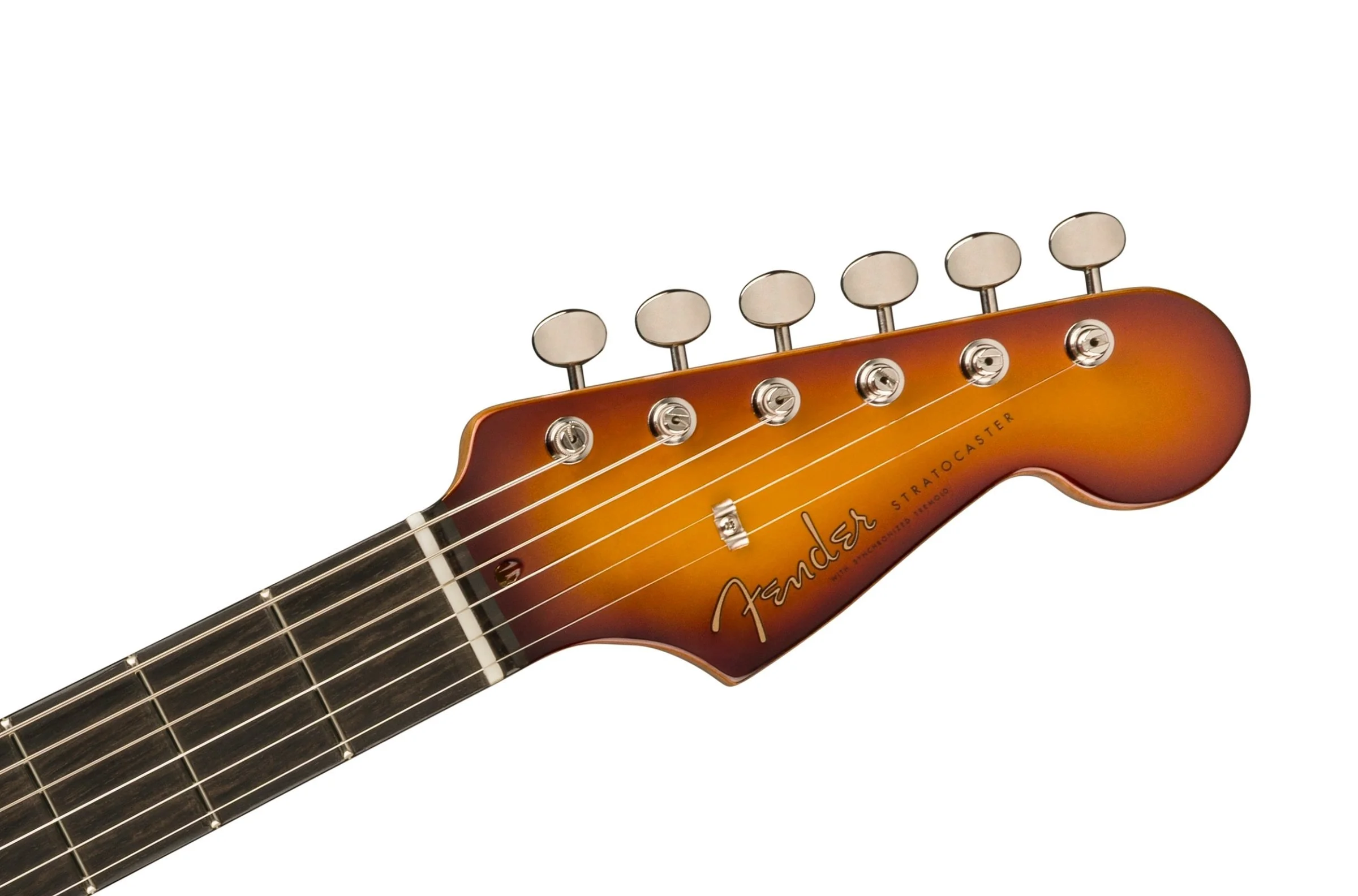Review : Fender Limited Edition Suona Guitars - Stratocaster & Telecaster
Hello everyone! I want to thank the great people at The Arts Music Store for arranging access to these instruments for this review. The support to my work of local guitar shops is integral to my getting you content that is interesting and useful.
Overview
Fender frequently does what they call Limited Edition instruments. They are commonly built on the frame of an existing model but have some unique design / build functions that separate them from the regular models. They truly are limited and once the program ends, the instruments are no longer available new. I have purchased a number of Fender LE instruments over the years and the ones that I chose all created a value to me.
The Suona instruments are available in three builds, the Telecaster and the Stratocaster reviewed here. There is also a Jazz Bass iteration. Suona sounded like something special and so I looked it up to find out what it means. I expected it to have something to do with a region of the world, or a manufacturing process, or even a wood blend. I was mistaken. A Suona is an old double reed wind instrument popular in China from the 16th century on, that may have originated further to the south. It has nothing to do with guitars or any stringed instruments, so is only a vaguely cool looking word.
So with that little bit, to me, of lunchbag letdown, let’s get into the guitars. The first is a Stratocaster style guitar, of the semi-hollow design, but with a solid spruce top over the chambered ash body. Fender calls it Italian Spruce, but in the spirit of clarity, this is not a distinct species. It is indeed a very fine softwood that has been used in instruments for centuries, but all European Spruces including Norway Spruce, French Spruce, German Spruce, Italian Spruce amongst many others identified by the country of harvest are the same species called Picea Abies. Fender is engaging in a bit of marketing to create a mental image of the tone wood quality found in Italian made violins. The body is ash, and the neck is flamed maple. The pickups are from Fender’s existing inventory, except the bridge which is called the Suona bridge although no detail on what makes it different is provided. The bridge and vibrato are traditional 50s Fender being a six point mount with bent steel saddles. Strings mount, as on most any Strat through holes in the bridge block accessible from the back.
The Telecaster, is like the Stratocaster, made at Fender’s California factory. It is semi-hollow with a solid spruce top, ash body and roasted flame maple neck with ebony fingerboard. The bridge is a rear loading design with compensated brass saddles.
The guitars come in a really well made hardshell case in blonde. The interior of the case is lined with a beautful red plush that is fitted precisely to the guitar body.
Stratocaster Specifications
Specifications - Telecaster
Initial Inspection and First Play - Stratocaster
There are many subtle differences in the Suona Stratocaster in addition to it being semi-hollow. Unlike on a regular Stratocaster, the edges of the top are not nearly as rounded, and feel more like the edges on an ‘80s shredder guitar. This has no impact on tone, but the body feel is thus different. Fender calls the neck profile a modern C and this strikes me as slimmer than the I suppose non-modern C. Still very comfortable. The nitro cellulose lacquer finish is beautifully done on this guitar. The burst looks nice, although all examples are identical. The pickups sound like a Stratocaster, I really could not tell any sonic difference over other Stratocasters that I own, except for the Eric Johnson Stratocasters which definitely sound different. My initial play was through a blonde Tone Master Deluxe Reverb, and I found the guitar to sound excellent with all five switch positions having very distinct tonal flavours.
I very much like the decision to go with a compound radius with the old style Fender 7.25” radius flattening out to 9.5” at the body. This is super comfortable and with a nice low action even big bends up the neck do not fret out. I have never liked Fender’s factory strings and this is true here as well. I think that this guitar would be amazing with a set of high quality strings.
The spruce top on the review instrument had great figuring for a thin wale spruce. There were also indications of what the marketplace likes to call Bear Claw. This doesn’t change the tone, it is a cosmetic thing only, but it did add character. The ash body is two piece and the figuring in the ash under the burst spray and nitro top coat looks terrific. The flame on the neck on the review instrument was outstanding, and far richer than on the Telecaster model that I saw. It is a roasted maple neck so has a pleasing darker tint.
The tuning machines are generic Fender machines. I would have much preferred the Fender Locking Tuners at this price point.
I had two issues and one concern with the instrument that I received for the review. It was as it arrived, and by my request had not been checked by the store. The store guys really hate when I ask for this. The neck had a reasonable amount of bow which was easily addressed, because the design is refined enough that you don’t have to take the neck off to do an adjustment. This is where I am concerned though. The truss rod wrench, which is supplied, is very small and the nut is positioned very deep. This means a non-standard truss rod wrench and in my opinion a huge opportunity to scratch the truss rod hole opening. Since the neck is maple, any abrasions shine like mad against the dark headstock paint job. Some form of heavy collar at the truss rod hole or even a truss rod cover would be a big improvement for little cost. The other issue was tuning stability. Esch player will choose how much float above the top is set in a Fender vibrato bridge/tailpiece. I like mine to float about a business card thickness off the top. This guitar arrived with a float of about 3/16” and so keeping it in tune was near impossible. It’s not hard to tighten up the claw screws to bring the baseplate down, but I was disappointed that the claw screws are really cheap, soft metal. I would replace these with stainless steel screws at the first opportunity, to avoid stripping the heads. If it were up to me, and it isn’t, I would prefer the two point bridge and tailpiece and Fender’s newer and I think better sustaining saddles. These are not bad in any way, I’m just not stuck in 1956.
The nut was cut perfectly and the only concern I have at the headstock is that the guitar has the ancient Fender string tree that looks like a gull flapping its wings. Again, I would replace this immediately with a Graph Tech frictionless string tree.
Once I made my adjustments to the neck and the bridge, the guitar played beautifully and now holds tune very well. With better strings it would be excellent I believe.
There are no batteries to worry about and the jack is a quality item that feels neither sloppy or so aggressive that you might need pliers to get the cord unplugged. The strap buttons are generic Fenders and while they are at least a V shape, they would get replaced with Planet Waves Elliptical buttons very quickly if the guitar were mine.
Initial Inspection and First Play - Telecaster
There are many subtle differences in the Suona Telecaster in addition to it being semi-hollow. Fender calls the neck profile a modern C and this strikes me as slimmer than the I suppose non-modern C. Still very comfortable. The nitro cellulose lacquer finish is beautifully done on this guitar. The burst looks nice, although all examples are identical. The pickups sound like a Telecaster, I really could not tell any sonic difference over other US Made Telecasters that I own. My initial play was through a blonde Tone Master Deluxe Reverb, and I found the guitar to sound excellent with all three switch positions having very distinct tonal flavours. That all said, I am a big fan of thinline Telecasters as I think the semi-hollow body improves harmonic resonance.
As with the Stratocaster, I very much like the decision to go with a compound radius with the old style Fender 7.25” radius flattening out to 9.5” at the body. This is super comfortable and with a nice low action even big bends up the neck do not fret out. I have never liked Fender’s factory strings and this is true here as well. I think that this guitar would be amazing with a set of high quality strings.
The spruce top on the review instrument is very regular and while you can tell it is two pieces, the join is lovely. The ash body is also two piece and the figuring in the ash under the burst spray and nitro top coat looks really nice but the Stratocaster body had much more character. Fender states that the neck is a roasted flame maple. The roasting is clear to see, but on this particular guitar, the flame was absent. The ebony fingerboard was excellent, but I suspect that there is dye involved to have it show so uniformly black..
The Modern C carve on the neck is comfortable, although I liked it better on the Stratocaster. On Telecasters, I personally prefer a more aggressive V carve.
The tuning machines are generic Fender machines. I would have much preferred the Fender Locking Tuners at this price point.
I had only one concern with the instrument that I received for the review. The truss rod wrench, which is supplied, is very small and the nut is positioned very deep. This means a non-standard truss rod wrench and in my opinion a huge opportunity to scratch the truss rod hole opening. Since the neck is maple, any abrasions shine like mad against the dark headstock paint job. Some form of heavy collar at the truss rod hole or even a truss rod cover would be a big improvement for little cost.
The nut was cut perfectly and the only concern I have at the headstock is that the guitar has the ancient Fender string tree that looks like a gull flapping its wings. Again, I would replace this immediately with a Graph Tech frictionless string tree.
The strap buttons are generic Fenders and while they are at least a V shape, they would get replaced with Planet Waves Elliptical buttons very quickly if the guitar were mine. Other than these quibbles on my part, the guitar was ready to go out of the box.
Stratocaster Example Sounds
I recorded all the samples using the Tone Master Blonde Deluxe Reverb using the DI out direct to the recording interface. I used an Empress Compressor Mark II in front of the amp. The reverb is from the amp itself. It’s a very comfortable guitar to play and did not create any cramping or aggravate my arthritis. Have a listen and decide for yourself. Unless noted otherwise, amp volume was at 5 bass and treble at 5, reverb at 3.
What you cannot hear here is how decent the guitar sounds acoustically. It is really smooth and buttery and I believe the semi-hollow body and that nice spruce top contribute to the tonal quality.
1 - Open G chord in each switch position moving from bridge to neck
2 - Simple blues lick, switch at 4 (neck/middle), first clean, second with WA Centavo
3 - Bridge pickup with WA Centavo
4 - Neck / middle with added Eventide Digital Delay and Eventide Chorus
5 - Bridge / middle no compressor, amp reverb at 7
All the examples were recorded in Logic Pro and mastered before export to MP3 with a TC Electronic MASTER X HD
Telecaster Example Sounds
I recorded all the samples using the Tone Master Blonde Deluxe Reverb using the DI out direct to the recording interface. I used an Empress Compressor Mark II in front of the amp. The reverb is from the amp itself. It’s a very comfortable guitar to play and did not create any cramping or aggravate my arthritis. Have a listen and decide for yourself. Unless noted otherwise, amp volume was at 5 bass and treble at 5, reverb at 3.
What you cannot hear here is how decent the guitar sounds acoustically. It is really smooth and buttery and I believe the semi-hollow body and that nice spruce top contribute to the tonal quality.
1 - Open G chord in each switch position moving from bridge to neck
2 - Bridge pickup only
3 - Bridge pickup with WA Centavo
4 - Middle with added Eventide Digital Delay and Eventide Chorus
5 - Neck no compressor, amp reverb at 7
All the examples were recorded in Logic Pro and mastered before export to MP3 with a TC Electronic MASTER X HD.
Likeability is very subjective. The Twisted Tele neck pickup didn’t do anything special for me, and the Custom Suono Bridge did not sound to me different from a stock US Telecaster bridge pickup.
Good To Go Kit
When getting started or even upgrading, there is often more to the success than just the guitar, so I have decided to include a Good To Go recommendation kit. For this guitar, here’s my kit list.
Fender Limited Edition Suona Stratocaster OR Fender Limited Edition Suona Telecaster Thinline
I’m going to recommend one of the Fender Tonemaster amps. I would lead with the Blonde Deluxe Reverb or alternatively the Super Reverb. Tonemaster amps sound fabulous live and are all ready to go for direct to interface recording.
High quality guitar cable - 20ft or less. Good cables last and are quiet. Cheap cables are a horror show. Consult your sales professional for their recommendation but I like cables from Pig Hog, Ernie Ball, Digiflex and D’Addario. Avoid coiled cables, they look cool to some but are noise factories.
Gig Bag - These guitars come with a hardshell case, so you may not need a gig bag, but if that is more convenient, get one of the better Mono bags.
Guitar Stand - Hercules make the best stands but you can often get a house brand that will hold the guitar when it is not in its case and you are not holding it
Guitar Strap - Every guitar needs a strap and every player, even sitting should use a strap. Gravity always works and a strap will save your guitar at some point. I recommend real leather that has suede on the inside, which helps rein in instruments that are neck heavy. My favourite straps come from Walker and Williams.
Tuner - No guitar is complete without a tuner that goes with it all the time. Pedal tuners are great, but every player needs an in case tuner, and the Snark tuners are hard to beat. I prefer the cheaper models that take clock batteries as for the difference in price to the rechargeable unit, you can order a sheet of batteries from Amazon, or you may find a card of them in the shop from D’Addario priced very low.
String Changing Tool - The D’Addario tools are great. One tool has a string winder, a string cutter and a bridge pin puller. Every guitarist needs this as every guitarist should learn to change his or her own strings. It’s not hard, and that quality guitar shop might even offer a free session on how to do string changes efficiently that you can attend live. Also, there will be about a zillion YouTube videos on the subject.
Wrap Up
The Suona Stratocaster is a really nice guitar but I cannot say that I found it more spectacular than another American Strat but I do like the thin line body very much. Unfortunately, the Telecaster impressed me less. Be assured that there is nothing wrong with the guitar, we just didn’t bond. Teles and I are like that. In Canada, MAP is $4139 for either model, so they are an expensive build. As these are Limited Edition instruments you might discover that finding one available is challenging. I can confirm that at time of writing, The Arts Music Store had a Stratocaster and a Telecaster in stock, but none of the bass model. They check every instrument before it leaves the store and they ship Canada wide. I very much like the thinline design. I have one FSR Strat and an Eric Johnson Strat that are both thinlines and in my opinion, that adds to their sonic palette. I also own a Thinline Telecaster that was featured in my article about the Vega Trem vibrato for Telecasters. I always encourage shopping with a dedicated guitar shop and verifying that they do a quality inspection and correction before the instrument leaves the store.
Thanks as always for reading! Please consider becoming a Patreon member to help support the channel. Please do send in comments and questions. I read and respond to all. For That Guitar Lover, I’m Ross Chevalier and we will engage again soon.











